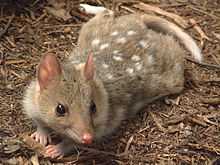Eastern quoll
| Eastern quoll[1] | |
|---|---|
 | |
| Eastern quoll | |
| Conservation status | |
| Scientific classification | |
| Kingdom: | Animalia |
| Phylum: | Chordata |
| Class: | Mammalia |
| Order: | Dasyuromorphia |
| Family: | Dasyuridae |
| Genus: | Dasyurus |
| Species: | D. viverrinus |
| Binomial name | |
| Dasyurus viverrinus (Shaw, 1800) | |
 | |
| Eastern quoll range | |
The eastern quoll (Dasyurus viverrinus), also known as the eastern native cat, is a medium-sized carnivorous dasyurid marsupial native to Australia. They are now considered extinct on the mainland, but remain widespread and even locally common in Tasmania. It is one of six extant species of quolls.
Taxonomy
The eastern quoll is a member of the family Dasyuridae, which includes most carnivorous marsupials. Its species name, viverrinus, indicates it is "ferret-like".[3] The species was first described in 1800 by George Shaw, who placed it in the opossum genus Didelphis, along with the only other then-known quoll, the tiger quoll.
Description
.jpg)
The eastern quoll is generally about the size of a small domestic cat, with an adult male averaging 60 cm and weighing around 1.3 kg. Its thick coat is covered by white spots, and ranges in colour from a light fawn to a near black, with an off-white belly. It can be distinguished from the tiger quoll by its slender build, pointed snout, and lack of spots on the tail.
Behaviour
The eastern quoll is a solitary predator, hunting at night for its prey of insects and small mammals. It has also been known to scavenge food from the much larger Tasmanian devil.
The breeding season begins in early winter, and the female gives birth up to 20 young.[4] Of these, the first to attach themselves to the six teats will be the only survivors. Weaning takes place at about 10 weeks of age, with the young staying in the den whilst the mother forages.
Habitat
They are widespread in Tasmania, and are found in rainforest, heathland, alpine areas, and scrub. However, they prefer dry grassland and forest mosaics, bounded by agricultural land, particularly where pasture grubs are common.
Threats
.jpg)
The main threats to the eastern quoll are competition and predation from feral cats and illegal poisoning and trapping. The lack of foxes and dingoes in Tasmania is believed to have contributed to the survival of the species.
Mainland extinction
The last mainland eastern quoll specimen was collected as roadkill in Sydney's Nielsen Park, Vaucluse on 31 January 1963.[5] The National Parks and Wildlife service reported numerous unconfirmed sightings until 1999 (the year of the report),[6] and the species was reported sighted as recently as 2006.[7] Specimens collected in 2005 and 2008 west of Melbourne, Victoria, are likely connected with a nearby Conservation and Research Centre, either as direct escapees, or the descendants of escapees from that facility.[8]
References
- ↑ Groves, C. P. (2005). Wilson, D. E.; Reeder, D. M, eds. Mammal Species of the World (3rd ed.). Baltimore: Johns Hopkins University Press. p. 25. OCLC 62265494. ISBN 0-801-88221-4.
- ↑ McKnight, M. (2008). Dasyurus viverrinus. In: IUCN 2008. IUCN Red List of Threatened Species. Retrieved 28 December 2008. Database entry includes justification for why this species is listed as near threatened
- ↑ Godsell, J. (1995). "Eastern Quoll". In Strahan, Ronald. The Mammals of Australia. Reed Books. pp. 70–71
- ↑ "Mammals" Dorling Kindersley Limited, London
- ↑ Australian Museum (2003). "Sydney mammals database, Eastern Quoll". Australian Museum. Retrieved 12 February 2007.
- ↑ National Parks and Wildlife Service (1999). "Threatened Species Information, Eastern Quoll". National Parks and Wildlife Service. Retrieved 12 February 2007.
- ↑ Rebecca Lang (2006-11-01). ""Extinct" marsupial may be alive and well - NSW". Hawkesbury News. Retrieved 12 February 2007.
- ↑ http://wherelightmeetsdark.com/index.php?module=wiki&page=VictorianEasternQuollSpecimens
